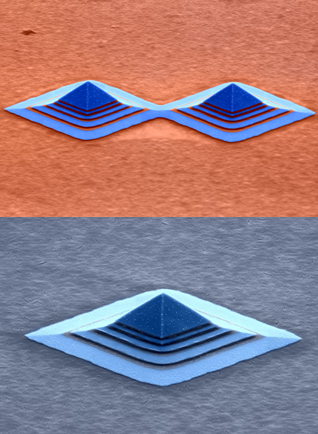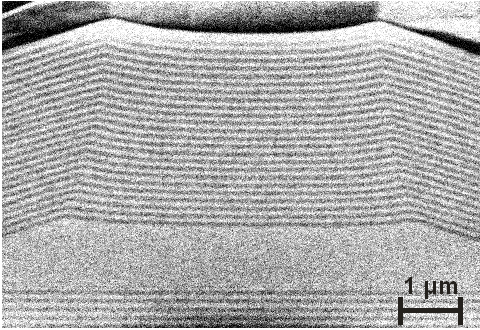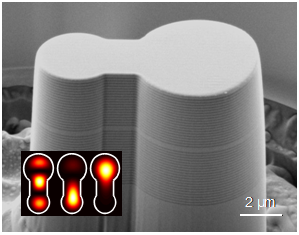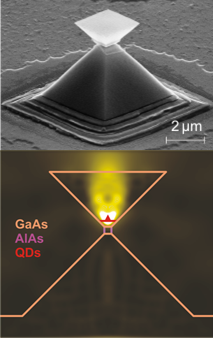A2.8: Optical Microcavities
Subproject Leader: Heinz Kalt and Michael Hetterich
Contributing Scientists:
Quantum-Mechanics with Light and Matter
The quantum-mechanic nature of the interaction of light and matter can be demonstrated impressively by the coupling of confined excitonic states to optical cavity modes in semiconductor heterostructures. According to the coupling strength of the excitonic and photonic states, one can observe an enhanced radiative decay of the excitons or even a mixing of the two states which is conventionally labeled as the weak and strong coupling regime, respectively. While the benefit of a weak coupling is an improved repetition rate and directivity of radiation that could end up in thresholdless lasing, a strong coupling of more than one excitonic state to a cavity mode would introduce a strong coupling of the excitons as well. Referring single qubits to these states, coupling of those could be the first step towards quantum computing.
The Prerequisites
The essential requirements to observe these so called cavity quantum electrodynamic (cQED) phenomena are the access to discrete excitonic states in high-quality and low volume optical micro-resonators. To this end, self-assembled InAs quantum-dots (QDs) have been embedded into GaAs micro-cavities, which can offer both, confined states in the QDs as well as high-quality optical modes. For single QD devices it is additionally desirable to get control over the exact position of the quantum dots, which is not possible in the lateral direction for self-assembled QDs. Therefore, we work in strong collaboration with subproject A2.6 that concentrates on the issue of QD positioning especially.
Pyramidal and Pillar Cavities
Pillar cavities are a classical approach to fabricate high-quality optical micro-resonators. They consist of a λ-cavity which is sandwiched between two distributed Bragg-reflectors (DBRs). The pillars themselves arethen revealed by anisotropic dry etching of the layer structure. Besides studies on these well investigated pillars [1], we established a novel class of pyramidal resonators which shows couple of advantages: The shape of the pyramids is fully controllable by the parameters of a wet-chemical etching process, the number of QDs can be controlled by the position of the QD layer in the pyramid, pyramids can be fabricated upright or reversed- simply spoken: They are much more flexible then the fixed pillar geometry [2, 3]. Additionally, we have realized a combination of both types of cavities, by the overgrowth of truncated pyramids with a DBR [4], which allowed us to benefit from the high reflectivity of the DBRs as well as the controllable shape of the pyramidal cavities.
Mode Coupling
In order to control the desired coupling of QD states e.g. through external local electric fields it would be favorably to position the QDs in separated cavities, whose modes are coupled, instead of having them in one cavity, where one hardly can access one of the QDs, exclusively. Therefore we have laterally coupled to pillar cavities of different radius such that two of their modes are energy matched. Simulation and experimental data showed the co-existents of modes that are localized in only one of the pillars and those which are extended over both [5]. Shifting the emission of one QD in and out of resonance with such extended mode could switch the coupling with another QD in the second resonator.
Non-Classical Light- Sources of Single Photons
Single-photon sources have gained a lot of interest in the contexts of a secure key transfer in quantum cryptography and proofs of fundamental quantum-mechanic effects. Since InAs QDs inherently emit only single photons at once and can be driven electrically, they have been favorable candidates for the realization of such devices. Their anti-bunching behavior can be proven in time-dependent autocorrelation spectroscopy and differs from classical light like laser emission or thermal light, where bunched photon emission is at least as likely as anti-bunched. Nevertheless, it has been a grave task to efficiently couple the isotropic radiation out of the optically dense GaAs matrix material and, on the other, to separate the self-assembled QDs, in such way that only a single one can be accessed. Both of these issues we have overcome by positioning of the QD layer at the tip of reversed pyramidal cavities, which ensures very few QDs in the cavity, on the one hand, and highly efficient out-coupling thanks to the cavity, on the other hand.
References
|
[1] |
M. Karl, B. Kettner, S. Burger, F. Schmidt, H. Kalt and M. Hetterich, Optics Express 17, 1144, (2009) |
|
[2] |
F.M. Weber, M. Karl, J. Lupaca-Schomber, W. Löffler, S. Li, T. Passow, J. Hawecker, D. Gerthsen, H. Kalt, and M. Hetterich, Appl. Phys. Lett. 90, 161104, (2007); featured in: Nature Photonics 1, 317, (2007), News & Views |
|
[3] |
M. Karl, T. Beck, S. Li, H. Kalt, and M. Hetterich, Appl. Phys. Lett. 92, 231105, (2008) |
|
[4] |
D. Rülke, M. Karl, D.Z. Hu, D.M. Schaadt, H. Kalt, and M. Hetterich, J. Crystal Growth (2011), in press |
|
[5] |
M. Karl, S. Li, T. Passow, W. Löffler, H. Kalt, and M. Hetterich, Optics Express 15, 8191, (2007) |
List of Publications 2006-2011 as PDF
Subproject Report 2006-2010 as PDF



